Edward Durell Stone
Edward Durell Stone (March 9, 1902 – August 6, 1978) was an American architect known for the formal, highly decorative buildings he designed in the 1950s and 1960s. His works include the Museum of Modern Art, in New York City, the United States Embassy in New Delhi, India, The Keller Center at the University of Chicago, and the John F. Kennedy Center for the Performing Arts in Washington, D.C.
Edward Durell Stone | |
|---|---|
 Stone (center) viewing a model of NASA's Electronics Research Center, 1964 | |
| Born | March 9, 1902 Fayetteville, Arkansas, United States |
| Died | August 6, 1978 (aged 76) New York City, New York, United States |
| Alma mater | University of Arkansas, Harvard University, M.I.T. |
| Occupation | Architect |
| Buildings | Radio City Music Hall, Museum of Modern Art, Kennedy Center, 2 Columbus Circle, First Canadian Place, Aon Center, University at Albany Uptown Campus |
Life and work
Stone was born and raised in Fayetteville, Arkansas. He attended the University of Arkansas, Harvard and M.I.T., but did not earn a degree.[1] In 1927 he won the Rotch Travelling Scholarship, which afforded him the opportunity to travel through Europe on a two-year stipend.[2] Stone was impressed by the new architecture he observed in Europe, buildings designed in what would come to be known as the International Style.[1] He returned to the United States in 1929 and took up residence in Manhattan. Hired by the architectural firm of Schultze and Weaver, he designed interiors for the new Waldorf-Astoria Hotel. He subsequently worked for the Associated Architects of Rockefeller Center and became the principal designer of Radio City Music Hall.[3]

Stone was an early advocate of the International Style. His first independent commission was the Richard H. Mandel House, in Mount Kisco, New York (1933).[4] This was followed by the Ulrich Kowalski house, also in Mt. Kisco (1934),[5] and the Albert C. Koch house in Cambridge, Massachusetts (1936).[note 1][6] In 1936 Stone was chosen as associate architect for the new Museum of Modern Art in New York City, designed in collaboration with Phillip Goodwin.[7] Stone also designed a private residence for MoMA president Anson Conger Goodyear in Old Westbury, NY (1938).[8] Both the Mandel and Goodyear residences are listed on the National Register of Historic Places.[9]
At the outset of World War II Stone enlisted in the U.S. Army. He was promoted to the rank of major and served as chief of the Army Air Force Planning and Design Section.[10] Returning to New York after the war, Stone was commissioned to design the ten-story El Panama Hotel in Panama City, Panama (1946),[11] the University of Arkansas Fine Arts Center in Fayetteville (1948),[12] and the 850-bed Hospital del Seguro Social del Empleado in Lima, Peru (1950).[note 2][13]
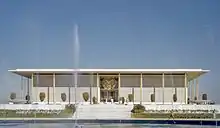
Stone’s best-known work was the Embassy of the United States in New Delhi, India (1959).[14] Tasked with creating a modern building that respected the architectural heritage of its host country, he designed a temple-like pavilion on a raised podium.[15] Frank Lloyd Wright called the embassy one of the most beautiful buildings he had ever seen,[16] and it won a first honor award from the American Institute of Architects (AIA).[17] Subsequent commissions such as the Stanford University Medical Center in Palo Alto, California (1955),[18] the Stuart Pharmaceutical Company in Pasadena, California (1956),[19] and the United States pavilion at the 1958 Brussels World’s Fair (1957),[20] repeated elements originally designed for the embassy.[21] The Stuart building and World’s Fair pavilion both won awards from the AIA,[17] and Stone was elected to the Institute’s College of Fellows in 1958.[22]
Described as romanticist,[23] Stone’s ornate designs brought him commercial success.[14] By the 1960s his firm was among the largest architectural practices in the United States, with over 200 employees and offices on both coasts.[24] Buildings from this period include the North Carolina State Legislative Building in Raleigh (1960),[25] the Pakistan Institute of Nuclear Science and Technology in Nilore (1961),[26] the National Geographic Society building in Washington, D.C. (1961),[27] the Museo de Arte in Ponce, Puerto Rico (1961),[28] the uptown campus of the University at Albany (1962),[29] the John F. Kennedy Center for the Performing Arts in Washington, D.C. (1962),[30] the General Motors building in New York City (1964), the PepsiCo World Headquarters, in Purchase, New York (1967),[31] the Florida State Capital complex in Tallahassee (1970),[32] and the Standard Oil building (now known as the Aon Center) in Chicago, Illinois (1970).[33]
Stone retired in 1974 and died in 1978.[10] Following a New York City funeral his ashes were buried in his hometown of Fayetteville.[34]
Stone also was the architect of Landmark College in Putney Vermont.
Honors and awards
Honorary degrees
Memberships and honors
- Medal of Honor, New York Chapter of the American Institute of Architects, 1955[39]
- American Institute of Architects, Fellow, 1958[22]
- National Institute of Arts & Letters, Member, 1958[40]
- National Urban League, Trustee, 1958[41]
- American Academy of Arts & Sciences, Fellow, 1960[42]
- American Federation of Arts, Trustee, 1960[43]
- National Institute of Social Sciences, Gold Medal, 1961[44]
- Building Stone Institute, Architect of the Year, 1964[45]
- Horatio Alger Award, 1971[46]
Architectural awards
- Silver Medal, Architectural League of New York, 1937 – Guest House for Henry R. Luce, Mepkin Plantation, Moncks Corner, South Carolina[47]
- Silver Medal, Architectural League of New York, 1950 – A. Conger Goodyear Residence, Old Westbury, New York[48]
- Gold Medal, Architectural League of New York, 1950 – Museum of Modern Art, New York City, New York (Philip Goodwin, Associate)[48]
- Gold Medal, Architectural League of New York, 1950 – El Panama Hotel, Panama City, Panama [49]
- First Honor Award, American Institute of Architects, 1958 – Stuart Pharmaceutical Co., Pasadena, California[17]
- Award of Merit, American Institute of Architects, 1958 – U.S. Pavilion, Brussels, Belgium[17]
- First Honor Award, American Institute of Architects, 1961 – U.S. Embassy, New Delhi, India[17]
- Award of Merit, American Institute of Architects, 1963 – Community Hospital of the Monterey Peninsula, Carmel, California[50]
- Honor Award, American Institute of Architects, 1967 – Ponce Museum of Art, Ponce, Puerto Rico[51]
Selected works

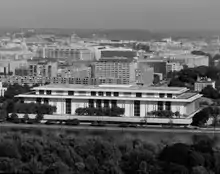

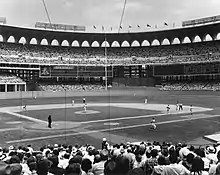
- Radio City Music Hall and the Center Theater, in Rockefeller Center, New York City (as senior designer in the employ of the Rockefeller Center Associated Architects with Donald Deskey and Eugene Schoen, interior designers, 1932)
- Richard H. Mandel House, Bedford Hills, New York (with Donald Deskey, interior designer, 1933)
- Mepkin Plantation for Mr. and Mrs. Henry R. Luce, (now known as Mepkin Abbey), Monck's Corner, South Carolina (1936)
- Museum of Modern Art, New York City, (Philip L. Goodwin, associate architect, 1937)
- A. Conger Goodyear House, Old Westbury, New York (1938)
- Ingersoll Steel, Utility Unit House, Kalamazoo, Michigan (1946)
- El Panama Hotel, Panama City, Panama (Mendez and Sanders, associated architects, 1946)
- Fine Arts Center, University of Arkansas, Fayetteville, Arkansas (Haralson & Mott, associated architects, 1948)
- United States Embassy, New Delhi, India (1954)
- Phoenicia InterContinental Hotel first phase, Beirut, Lebanon (Elias and Dagher, associated architects, 1954. Second phase by Joseph Philippe Karam, then altered 1997)
- Stanford Medical Center, Palo Alto, California (1955)
- Bruno & Josephine Graf Residence, Dallas, Texas (1956)
- Main Library and Mitchell Park Branch Library, Palo Alto, California (1956, Mitchell Park Branch demolished 2010)
- Edward Durell Stone Townhouse, 130 East 64th Street, New York City (1956)
- Stuart Pharmaceutical Co., Pasadena, California (1956, partially demolished)
- U.S. Pavilion at Expo 58, Brussels, Belgium (1957, partially demolished)
- First Unitarian Society Church, Schenectady, New York (1958)
- Gallery of Modern Art, including the Huntington Hartford Collection (now known as Museum of Arts & Design), New York City (1958, substantially altered 2006)
- International Trade Mart (now known as Four Seasons Hotel and Private Residences New Orleans), New Orleans, Louisiana (Robert Hall, associate architect, 1959)
- Robert M. Hughes Memorial Library, Norfolk, Virginia (1959, substantially altered 2011)
- Harvey Mudd College, Claremont, California (1959)
- North Carolina State Legislative Building, Raleigh, North Carolina (Holloway-Reeves & Associates, associated architects, 1960)
- Beckman Auditorium, California Institute of Technology, Pasadena, California (1960)
- National Geographic Society Museum, Washington, D.C. (1961)
- Museo de Arte, Ponce, Puerto Rico (1961)
- Windham College (now known as Landmark College), Putney, Vermont (1961)
- State University of New York at Albany, Albany, New York (1962)
- John F. Kennedy Center for the Performing Arts, Washington, D.C. (1962)
- Prince George's Center (now known as University Town Center), Hyattsville, Maryland (1962)
- Busch Memorial Stadium, St. Louis, Missouri (1962, demolished 2005)
- WAPDA House, Lahore, Pakistan (1962)
- Stuhr Museum of the Prairie Pioneer, Grand Island, Nebraska (1963)
- Claremont School of Theology, Claremont, California (1963)
- P.S. 199 School, Lincoln Square/Upper West Side, New York (1963)
- Davenport Public Library, Davenport, Iowa (1964)
- General Motors Building, New York City (Emory Roth and Sons, associated architects, 1964)
- Ethel Percy Andrus Gerontology Center, University of Southern California, Los Angeles, California (1964)
- Tulsa Convention Center, Tulsa, Oklahoma (Murray, Jones and Murray, associated architects, 1964, expanded and renamed to Cox Business Center)
- Von KleinSmid Center, University of Southern California, Los Angeles, California (1964)
- Garden State Arts Center (now known as PNC Bank Arts Center), Holmdel, New Jersey (1965)
- Pakistan Institute of Nuclear Science and Technology, (1965)
- Georgetown University Law Center Bernard P. McDonough Hall, Washington, D.C. (1966)
- Westgate Tower, Austin, Texas (1966)
- Brith Emeth Temple, Pepper Pike, Ohio (1967)
- Fort Worth City Hall, Fort Worth, Texas (1967)
- Kirwan-Blanding Complex, University of Kentucky, Lexington, Kentucky (1967; demolished 2020)
- PepsiCo World Headquarters Complex, Purchase, New York (1967)
- Jefferson County Civic Center, Pine Bluff, Arkansas (1968)
- Worcester Science Museum (now known as the EcoTarium), Worcester, Massachusetts, (1964, altered 1998)
- Aiwan-e-Sadr (1970),Islamabad
- Eisenhower Medical Center, Rancho Mirage, California (1971)
- W.E.B. Du Bois Library, University of Massachusetts Amherst, Amherst, Massachusetts (1971)
- Amarillo Museum of Art, Amarillo, Texas (1972)
- Standard Oil Building (now known as Aon Center), Chicago, Illinois (Perkins & Will, associated architects, 1972)
- Buffalo News Building, Buffalo, New York (1973)
- Scripps Green Hospital, La Jolla, California (1974)
- First Bank Building (now known as First Canadian Place), Toronto, Ontario (1975)
- Babin Kuk Resort, Dubrovnik, Croatia (1976)
- Florida State Capitol, Tallahassee, Florida (Reynolds, Smith & Hills, associated architects, 1977)
- University of Alabama School of Law, Tuscaloosa, Alabama (1977)
- Scripps Anderson Outpatient Pavilion, La Jolla, California (by Edward Durell Stone Associates, 1983)
- Government Center Station, Miami, Florida (1984)
- Scripps Research Institute, La Jolla, California (by Edward Durell Stone Associates, 1985)
- Museum of Anthropology, Xalapa, Veracruz, Mexico (by Edward Durell Stone Associates, 1986)
Gallery
 Radio City Music Hall
Radio City Music Hall
New York, New York
(1932) Anson Conger Goodyear House
Anson Conger Goodyear House
Old Westbury, New York
(1938) Anson Conger Goodyear House
Anson Conger Goodyear House
Old Westbury, New York
(1938)


 Palo Alto Main Library
Palo Alto Main Library
Palo Alto, California
(1956)
 United States Pavilion
United States Pavilion
Expo 1958
Brussels, Belgium
(1957) First Unitarian Society
First Unitarian Society
Schenectady, New York
(1958)

 National Geographic Society Headquarters
National Geographic Society Headquarters
Washington, D.C.
(1961)




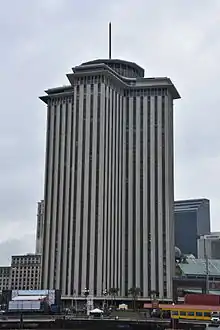
 PepsiCo Headquarters
PepsiCo Headquarters
Purchase, New York
(1967)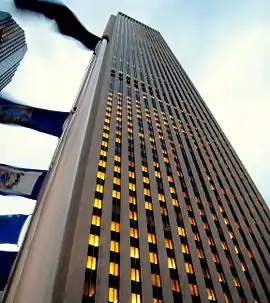
 First Canadian Place
First Canadian Place
Toronto, Ontario, Canada
(1975)
Footnotes
Notes
- The Koch house was designed in association with Carl Koch, Jr.
- The hospital was designed in association with Alfred L. Aydelott.
Citations
- Stone 1962.
- "Tech Student Wins Rotch Scholarship," Boston Herald, May 4, 1927.
- Hunting 2013.
- "House of Richard H. Mandel," Architectural Forum, August 1935.
- "Recent Work by Edward D. Stone," Architectural Forum, July 1941.
- "Grand Prize: Prize Houses Over $12,000," Architectural Forum, January 1939.
- "Current Architecture: The Museum of Modern Art, New York City," Architectural Review, September 1939.
- "Recent Work by Edward D. Stone".
- National Register of Historic Places Single Property Listings Finding Aid: New York, (Tucson: National Park Service Intermountain Region Museum Services Program, 2017).
- Stone 2011.
- The Architectural Forum. 94. Billboard Publications. 1951. p. 139. Retrieved May 9, 2020.
- "University Art Center—Architect Stone’s sure hand with countless details creates a harmonious home for seven arts under one Arkansas roof," Architectural Forum, September 1951.
- "Big Double Hospital: Skillful handling of traffic and service flow by US architects integrates maternity and general health facilities for 850 Peruvian inpatients," Architectural Forum, June 1952.
- Goldberger, Paul (August 7, 1978). "Edward Durell Stone Dead at 76; Designed Major Works Worldwide". The New York Times. p. A1. Retrieved April 27, 2020.
- Jane C. Loeffler, The Architecture of Diplomacy (New York: Princeton Architectural Press, 1998).
- "It's news when Wright lauds an architect," Palo Alto Times, August 3, 1955.
- von Eckardt 1961.
- "Medicine’s new 'Taj Mahal'," Architectural Forum, April 1958.
- "Splendor in the Factory," Architectural Record, December 1959.
- "A final look at Brussels," Architectural Forum, October 1958.
- Steven Bedford, "Stone, Edward Durell," in Encyclopedia of Architecture Design, Engineering & Construction, ed. by Joseph A. Wilkes and Robert T. Packard (New York: Wiley, 1989).
- "HONOR FOR ARCHITECTS; Four Here Are Among Twenty Elected to Institute". The New York Times. April 27, 1958. p. 81. Retrieved April 27, 2020.
- Stone 1967.
- "100 Largest Architectural Firms in the U.S.," Architectural Forum, April 1963; "100 Largest Architectural Firms in the U.S.," Architectural Forum, April 1964; "Man with a billion on the drawing board," Business Week, October 8, 1966.
- "New Statehouse for North Carolina," Architectural Forum, December 1963.
- "Architecture: Mogul Modern," Time, August 12, 1966.
- Ada Louise Huxtable, "Architecture: In Capitol: National Geographic Society’s Building Sets a Standard for Washington," New York Times, December 11, 1963.
- "Ponce: Design for a Temperate Climate," Architectural Record, April 1966.
- Douglas Dales, "Model of College Shown by State," New York Times, June 12, 1962.
- Robert Hughes, "The New Monuments," Time, September 13, 1971.
- "From Park Avenue to an old polo Field: a lush new setting for PepsiCo’s headquarters," Architectural Record, February 1972.
- "Florida: The Legislature: The multi-phased construction program of the new capitol complex in Tallahassee," Interior Design, January 1979.
- "Block-Buster Approach to Architecture," Progressive Architecture, April 1970.
- Williams 1984, p. 52.
- "Art for Arkansas," "Interiors", July 1951, 12.
- Hunting, "Edward Durell Stone".
- "12 Graduated at Otis Art Institute". Los Angeles Times. June 15, 1961. p. 65. Retrieved May 9, 2020.
- "Today's Youth Called Mature and Dedicated," New York Times, May 13, 1962.
- "Honors," Architectural Record, July 1955, 16.
- Sandra Knox, "Prizes are given in Arts, Letters," New York Times, May 22, 1958.
- "Negro Aid Termed Good for Business," New York Times, September 11, 1958.
- "Academy Elects 116," New York Times, May 12, 1960.
- "Arts Group Elects 10," New York Times, April 22, 1960.
- "Social Science Awards," New York Times, December 14, 1961; “Architects in the News: Elder Named at B.C.; Kahn, Stone, Saarinen Honored,” Architectural Record, May 1962, 58.
- "Edward Durell Stone Cited by Building Stone Institute," New York Times, August 23, 1964; “People / Stone Wins Stone Award,” AIA Journal, October 1964, 84.
- "Alger Award Voted to Lowell Thomas," New York Times, May 12, 1971.
- "Architects Award Prizes in 3 Fields," New York Times, April 22, 1937.
- "ART AWARDS ANNOUNCED; Architectural League Gives Medals in Gold Medal Show". The New York Times. June 2, 1950. Retrieved April 27, 2020.
- "Wins Gold Medal Award Of Architectural League," New York Times, January 18, 1952.
- Thomas Ennis, “Institute Honors 13 New Projects: Progress Toward ‘Delight in Environment’ Noted,” New York Times, June 2, 1963.
- John Leo, “Skidmore, Owings Is Presented With 5 Of Architects’ 20 Awards: Architects Give Annual Awards,” New York Times, May 16, 1967; “Edward Durell Stone Museo de Arte de Ponce,” AIA Journal, June 1967, 47.
Works cited
- Stone, Edward Durell (1962). The Evolution of an Architect. Horizon Press. OCLC 929669.
- Stone, Hicks (2011). Edward Durell Stone: A Son's Untold Story of a Legendary Architect. Random House Incorporated. ISBN 978-0-8478-3568-3.
- von Eckardt, Wolf (1961). Mid-century Architecture in America: Honor Awards of the American Institute of Architects, 1949-1961. Johns Hopkins Press.
- Hunting, Mary Anne (2013). Edward Durell Stone: Modernism's Populist Architect. W.W. Norton. ISBN 978-0-393-73301-3. Retrieved May 9, 2020.
- Williams, John Griffith (1984). The curious and the beautiful: a memoir history of the architecture program at the University of Arkansas. University of Arkansas Press. ISBN 9780938626329. Retrieved May 9, 2020.
- Stone, Edward Durell (1967). Edward Durell Stone: Recent and Future Architecture. New York: Horizon Press.
General references
- Everett, Derek R. "Modern Statehouses for Modern States: Edward Durell Stone's Capitol Architecture in North Carolina and Florida." Southern Historian, Vol. 28 (Spring 2007): pp. 74–91.
- Head, Jeffrey. "Unearthing Stone." Metropolis magazine, Urban Journal, January 2008.
- Heyer, Paul. Architects on Architecture: New Directions in America. (New York: Walker & Co., 1966): pp. 172–183.
- Hunting, Mary Anne. "Edward Durell Stone, Perception and Criticism." (PhD diss., Graduate Center, City University of New York, 2007).
- Hunting, Mary Anne. “Edward Durell Stone.” In Oxford Bibliographies in Architecture, Planning, and Preservation. New York: Oxford University Press, forthcoming.
- Hunting, Mary Anne. "From Craft to Industry: Furniture designed by Edward Durell Stone for Senator Fulbright." The Magazine Antiques (May 2004): 110–121.
- Hunting, Mary Anne. “Legacy of Stone: As Campus Buildings Rise and Fall, A Leading Mid-20th-Century Architect’s Vision Endures,” Vanderbilt Magazine (Summer 2014): *18–19, 78–79.
- Hunting, Mary Anne. "The Richard H. Mandel House in Bedford Hills, New York." Living with Antiques.The Magazine Antiques (July 2001): 72–83.
- Hunting, Mary Anne. "Rediscovering the Work of Edward Durell Stone". Modern Magazine (Spring 2013): 70 and 72.
- Ricciotti, Dominic. "Edward Durell Stone and the International Style in America: Houses of the 1930s." American Art Journal, Vol. 20, No. 3 (Summer 1988): pp. 48–73.
- Ricciotti, Dominic. "The 1939 Building of the Museum of Modern Art: The Goodwin-Stone Collaboration." American Art Journal, Vol. 17, No. 3 (Summer 1985): pp. 51–76.
External links
| Wikimedia Commons has media related to Edward Durell Stone. |
- The Edward Durell Stone web site, a resource for current information on the life and work of Edward Durell Stone
- Finding Aid for the Edward Durell Stone Papers at The University of Arkansas, David W. Mullins Library, Department of Special Collections
- Finding Aid for the James Hicks Stone Papers at The University of Arkansas, David W. Mullins Library, Department of Special Collections
- The Edward Durell Stone entry in The Encyclopedia of Arkansas History & Culture by Robert L. Skolmen
- An Edward Durell Stone biography established and maintained by the State University of New York at Albany
- Photographs of the Bruno and Josephine Graf house in Dallas, Texas
- Ethel Goodstein-Murphree, "In Memoriam: Edward Durell Stone's Carlson Terrace, 1957-2007"
Two views on 2 Columbus Circle
